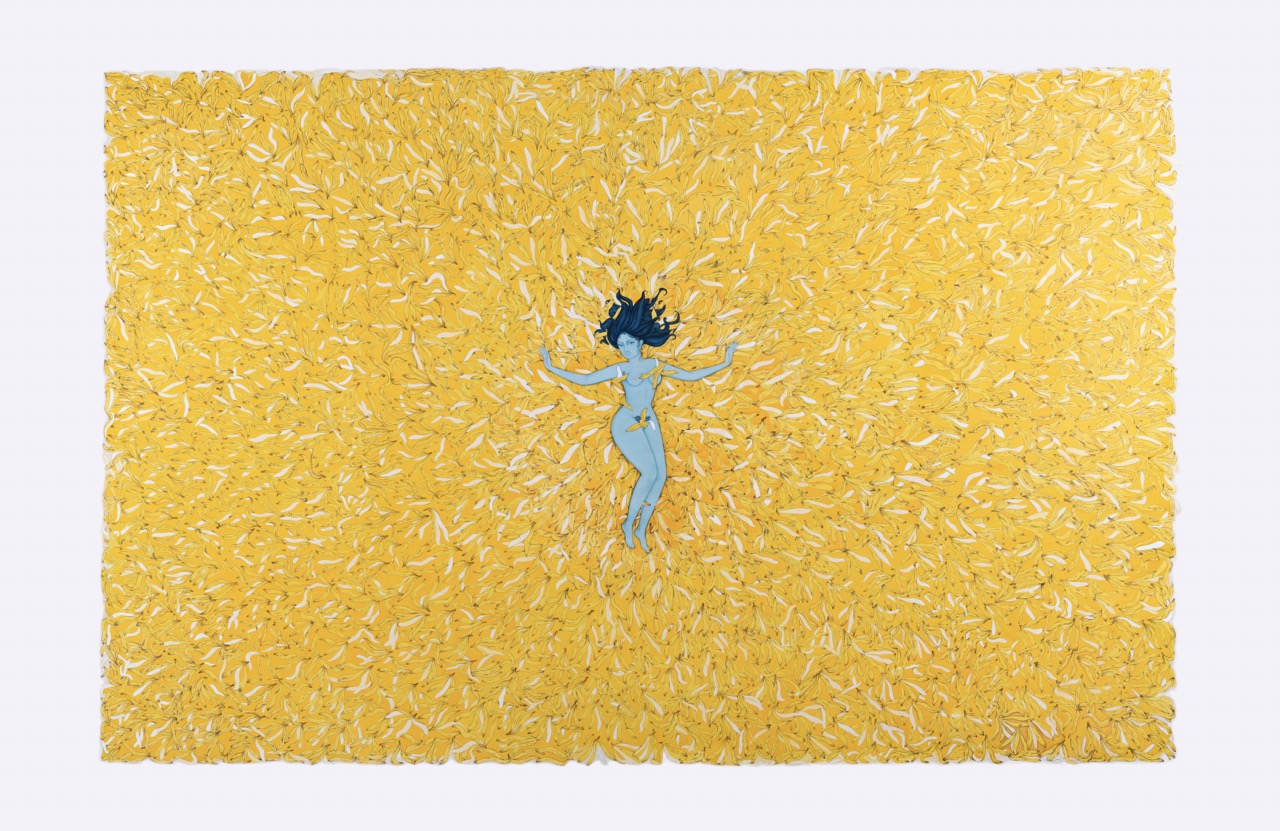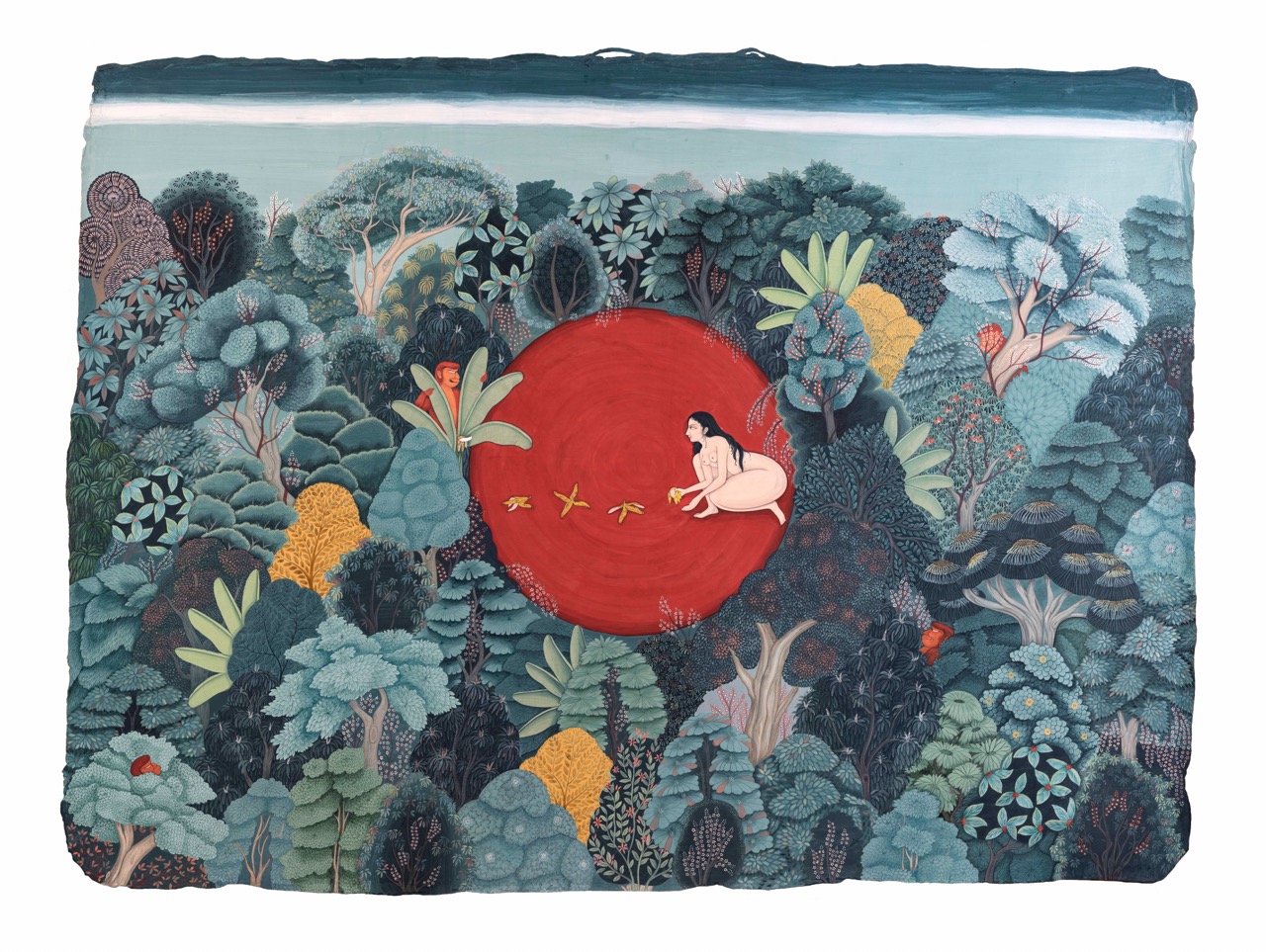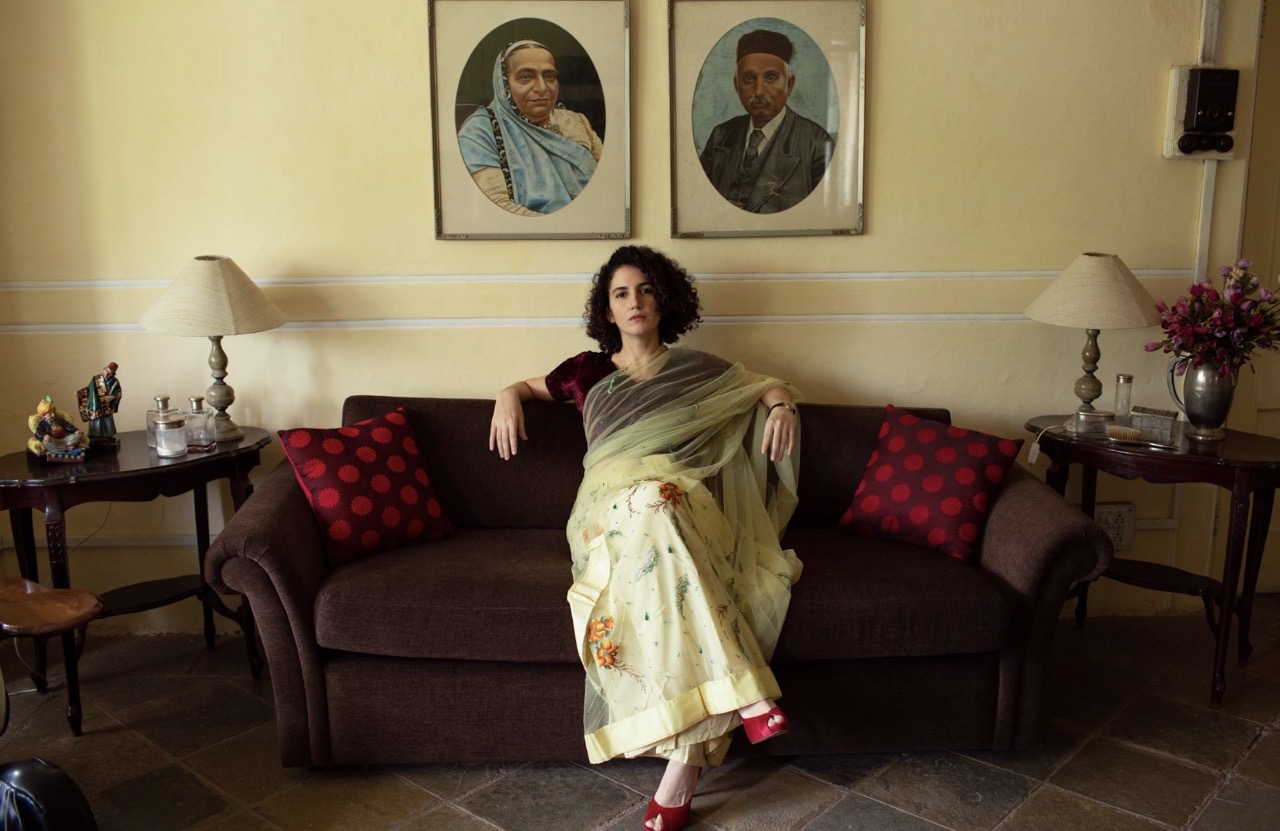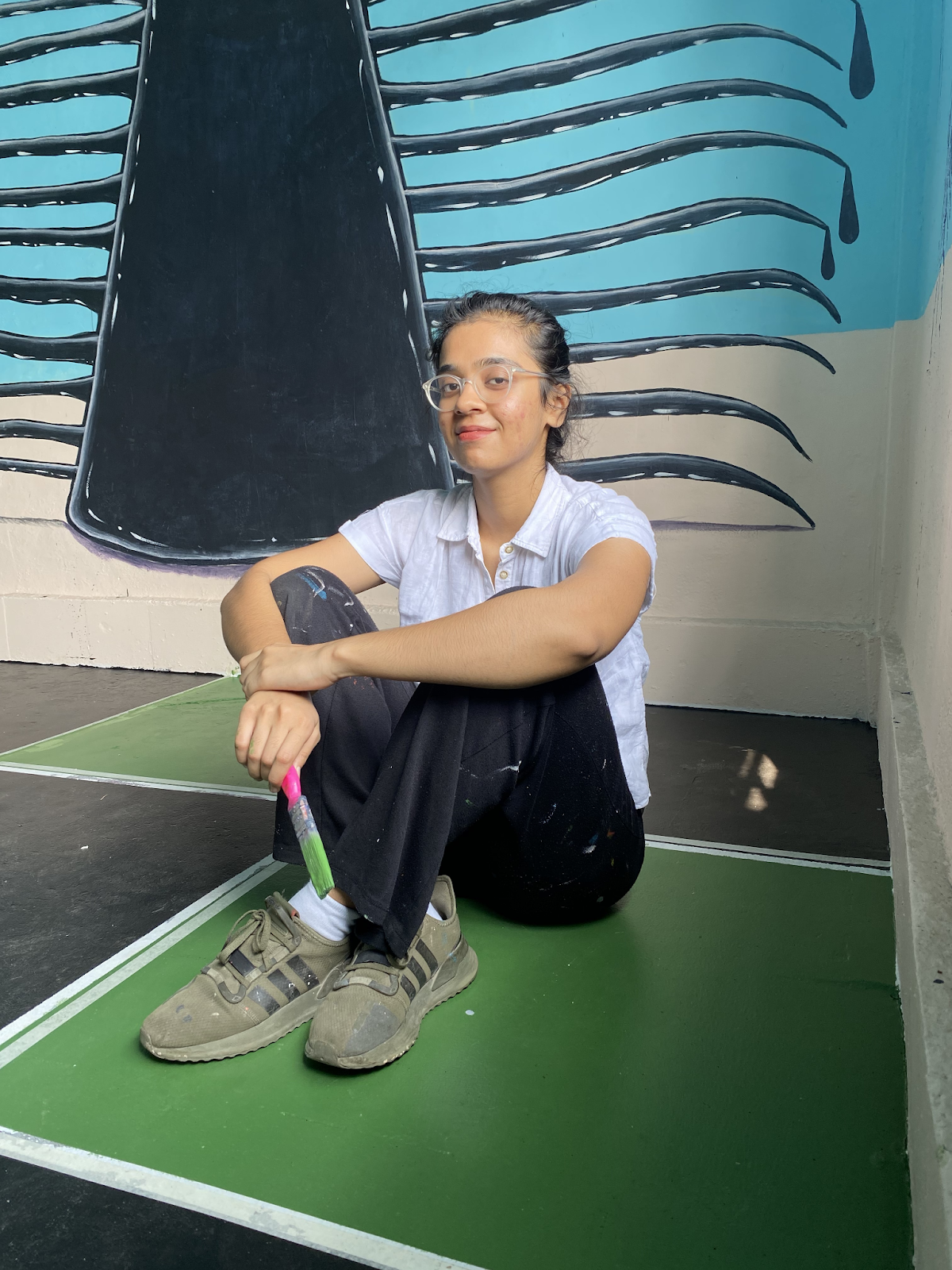A visual artist trained in the Kangra painting style, Gargi Chandola’s layered works explore themes of sexuality, dominance and consumption. Her most recent series of paintings Macaqophony, presents the feminine archetype, the nayika, caught in a constant struggle with a troupe of mischievous rhesus monkeys over a banana. In a recent interview with Art Fervour, Gargi tells us the story behind how the various elements and characters came together, and her personal relation to each.

Bite Me. Opaque Watercolor on Wasli. Image Courtesy the artist.
The Macaqophony series found its beginnings during the lockdown, when the artist who lives and works next to the Asola-Bhatti Wildlife Sanctuary in New Delhi, found time to create new work as well as observe the visiting rhesus macaques at close range.
Amidst the diverse flora and fauna surrounding her home-studio, Gargi often experiences the increasingly common phenomenon of animals venturing into urban areas due to human encroachment on their natural habitats. In paintings like Foreplay in the Forest, she subtly alludes to her suburban environment with transmission towers looming in the distance.

Foreplay in The Forest. Opaque Watercolor on Wasli. Image Courtesy the artist.
When examining the sketches and paintings she was creating during lockdown, it became evident that her work was telling stories about territory, ownership, and privilege with an erotic dimension.
She spent a considerable portion of her time devising strategies to chase away the monkeys, who frequently appeared in large groups, causing disruption and chaos. Her compositions began to reflect the power dynamics and territorial disputes she observed in her dealings with the monkeys while also serving as a metaphor for the broader societal desire for power.
The monkeys’ relentless pursuit of food and territory serves as a mirror to human nature, reflecting our insatiable desire for more. Despite their apparently aggressive and hostile presence in her work, Gargi appreciates the macaques for their intelligence and endearing nature, rendering them with care and precision.

Treasure Hunt. Opaque Watercolor on Wasli. Image Courtesy the artist.
The humble banana emerges as a powerful metaphor for the resources and agency that individuals must fight for in a society driven by power. Its phallic connotations allude to domination as an essential aspect of societal structure, just as nutrition is crucial for survival.
Gargi’s self-described “phallic fixation” parallels the monkeys’ fascination with the banana. The symbolism coupled with the power dynamics at play, creates an evocative commentary on the interplay between sexuality, dominance, and control.

Before The Fall. Opaque Watercolor on Wasli. Image Courtesy the artist.
Gargi sees the world around her appearing overtly masculine and the same is reflected in her paintings. The nayika’s use of masculine power to gain control of the banana forces her to embrace her primal instincts, symbolising the animalistic nature of the power struggle. This levelling of the playing field, where the nayika abandons her feminine traits to compete, reflects the entrenched social hierarchies that often necessitate the sacrifice of one’s identity for a sense of agency.
“The feminine is yet to appear in my work”, Gargi states. This near absence of feminine gestures — save for the occasional shy glance or the supine recline — replaced by the fight for dominance, calls into question the binary nature of femininity and masculinity. Which of the two qualities does a naked female figure wrestling with a monkey evoke?
The nayika, though a central figure, is not the ultimate heroine, she is not an all-powerful goddess destroying evil, as she too is embroiled in the pursuit of power and caught in the cycle of consumerism.
To the artist, the nayika is an exhibitionist embodying vanity and self-obsession. She revels in the attention she receives from the monkeys’ gaze. Despite the situational humour present in Gargi’s works, she interprets this portrayal as a cautionary tale for herself, perhaps warning of the risks involved in challenging both monkeys and patriarchal structures single-handedly.

Feast. Opaque Watercolor on Wasli. Image Courtesy the artist.
When asked whether a victor may eventually emerge between the nayika and the monkeys, Gargi responds that she intends to leave us unsatiated. For her, the compositions represent small battles rather than a full-fledged war. She draws a parallel to the emergent storytelling technique found in the Pahari painting style, where each painting is a vignette rather than a complete narrative.
Gargi’s training in the Kangra style of painting is evident in the meticulous attention to detail in every painting.
To further develop her skills, Gargi frequently visits Kangra Valley in Himachal Pradesh, where she works closely with her gurus at their painting studios. Her training follows the traditional guru-shishya parampara, a mentorship model in which the student is involved in various tasks to serve and learn from the guru. “They are more like family”, she says of her teachers.
Gargi is unsurprisingly the only female student in the studio, much like the solitary feminine figure in her compositions. When asked about her gurus’ reactions to the sexual themes and nudity in her work, Gargi refers to her teachers as “true artists” who reserve their judgement for the quality of the work itself, rather than its subject matter.

Eat Dust. Opaque Watercolor on Wasli. Image Courtesy the artist.
Gargi is presently working on a new series of paintings that may be seen as a natural progression from Macaqophony, with a continued focus on the aesthetics of consumption. The new body of work will incorporate a variety of phallic shapes beyond the banana, along with the addition of a leopard that recently wandered away from the wildlife sanctuary, which the artist caught on her CCTV camera. The elements may change, she says, but her new work continues to explore themes of power, desire, and human complexity.
Check out Gargi Chandola’s work in ‘Off margins: Miniatures in the Postmodern’, on view at Art and Charlie, Mumbai until 13 April 2024.
Get to Know the Artist
Describe your art in 3 words: Experience it yourself!
Favourite artist: Shahzia Sikander, Salman Toor
What are you listening to currently? Mujhe Tum Nazar Se Gira Toh Rahe Ho Mehdi Hassan
The last exhibition you saw? Raghu Rai’s ‘A Thousand Lives’ at KNMA Saket, New Delhi
Your advice for new artists? Practise daily like its riyaz
Favourite place to create art: My studio
What do you do to get out of a creative block? Take a step and come back to it. If it still doesn’t work then just force yourself to sit everyday in the studio regardless of you doing nothing. Sometimes pushing through a block works best.





